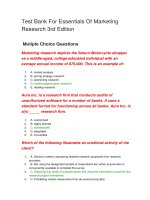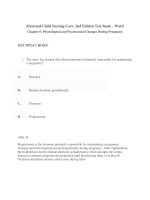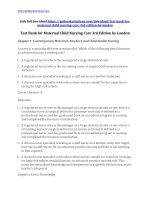Test bank for maternal child nursing care 3rd edition by london
Bạn đang xem bản rút gọn của tài liệu. Xem và tải ngay bản đầy đủ của tài liệu tại đây (601.26 KB, 15 trang )
Link full download: />
Test Bank for Maternal Child Nursing Care 3rd Edition by London
Chapter 1: Contemporary Maternal–Newborn and Child Health Nursing
A nurse is examining different nursing roles. Which of the following best illustrates
an advanced practice nursing role?
1. A registered nurse who is the manager of a large obstetrical unit
2. A registered nurse who is the circulating nurse at surgical deliveries (cesarean
sections)
3. A clinical nurse specialist working as a staff nurse on a mother–baby unit
4. A clinical nurse specialist with whom other nurses consult for her expertise in
caring for high-risk infants
Correct Answer: 4
Rationale:
1. A registered nurse who is the manager of a large obstetrical unit or one who is a
circulating nurse at surgical deliveries (cesarean sections) is defined as a
professional nurse, and has graduated from an accredited program in nursing
and completed the licensure examination.
2. A registered nurse who is the manager of a large obstetrical unit or one who is a
circulating nurse at surgical deliveries (cesarean sections) is defined as a
professional nurse, and has graduated from an accredited program in nursing
and completed the licensure examination.
3. A clinical nurse specialist working as a staff nurse on a mother–baby unit might
have the qualifications for an advanced practice nursing staff but is not working
in that capacity.
4. A clinical nurse specialist with whom other nurses consult for expertise in caring
for high-risk infants would illustrate an advanced practice nursing role. This
nurse has specialized knowledge and competence in a specific clinical area, and is
master’s-prepared.
Cognitive Level: Knowledge
Category of Client Need: Safe, Effective Care Environment
Nursing Process: Assessment
Learning Outcome: 1.1 Identify the nursing roles available to maternal-newborn and
pediatric nurses.
Chapter 01_LO01_Q02
The major focus of the nurse practitioner is on:
1.
2. Physical and psychosocial clinical assessment.
3. Independent care of the high-risk, pregnant client.
4. Tertiary prevention.
Correct Answer: 2
Rationale:
1. Leadership might be a quality of the NP, but it is not the major focus.
2. Physical and psychosocial clinical assessment is the major focus of the nurse
practitioner (NP), who provides care in many different clinical settings.
3. NPs cannot provide independent care of the high-risk pregnant client, but must
work under a physician’s supervision.
4. The NP cannot do tertiary prevention as a major focus.
Cognitive Level: Knowledge/Comprehension
Category of Client Need: Safe, Effective Care Environment
Nursing Process: Assessment
Learning Outcome: 1.1 Identify the nursing roles available to maternal-newborn and
pediatric nurses.
Chapter 01_LO01_Q03
The role of the certified nurse–midwife (CNM) is to: (Select all that apply.)
1. Be prepared to manage independently the care of women at low risk for
complications during pregnancy and birth.
2. Give primary care for high-risk clients who are in hospital settings.
3. Give primary care for healthy newborns.
4. Obtain a physician consultation for any technical procedures at delivery.
5. Be educated in two disciplines of nursing.
Correct Answers: 1; 3; 5
Rationale:
1. A CNM is prepared to manage independently the care of women at low risk for
complications during pregnancy and birth and the care of healthy newborns.
2. CNMs cannot give primary care for high-risk clients who are in hospital settings.
The physician provides the primary care.
3. A CNM is prepared to manage independently the care of women at low risk for
complications during pregnancy and birth and the care of healthy newborns.
4. The CNM does not need to obtain a physician consultation for any technical
procedures at delivery.
5. The CNM is educated in the disciplines of nursing and midwifery.
Cognitive Level: Knowledge/Comprehension
Category of Client Need: Safe, Effective Care Environment
Nursing Process: Planning
Learning Outcome: 1.1 Identify the nursing roles available to maternal-newborn and
pediatric nurses.
Chapter 01_LO02_Q04
During the hospital admission process, the child’s parent receives information about
the pediatric unit’s goals, including the statement that the unit practices “familycentered care.” The parent asks why that should be important. The nurse would
respond that in the “family-centered care” paradigm, the:
1. Mother is the principal caregiver in each family.
2. Child’s physician is the key person in assuring the health of a child is maintained.
3. Family serves as the constant influence and continuing support in the child’s life.
4. Father is the leader in each home; thus, all communications should include him.
Answer: 3
Rationale:
1. Culturally competent care recognizes that both matriarchal and patriarchal
households exist.
2. The physician is not present during the day-to-day routines in a child’s life
3. The foundation for the development of trusting relationships and partnerships
with families is the recognition that the family is the principal caregiver, knows
the unique nature of each individual child best, plays the vital role of meeting the
child’s needs, and is responsible for ensuring each child’s health.
4. Culturally competent care recognizes that both matriarchal and patriarchal
households exist.
Cognitive Level: Knowledge/Comprehension
Category of Client Need: Health Promotion and Maintenance
Nursing Process: Planning
Learning Outcome: 1.2 Summarize the use of community-based nursing care in
meeting the needs of childbearing and childrearing families
Chapter 01_LO03_Q05
Despite the availability of State Children’s Health Insurance Programs (SCHIPs),
many eligible children are not enrolled. The nursing intervention that can best help
eligible children become enrolled is:
1. Assessment of the details of the family’s income and expenditures.
2. Case management to limit costly, unnecessary duplication of services.
3. Advocacy for the child by encouraging the family to investigate its SCHIP
eligibility.
4. Education of the family about the need for keeping regular well-child visit
appointments.
Answer: 3
Rationale:
1. Financial assessment is more commonly the function of a social worker.
2. The case management activity mentioned will not provide a source of funding,
and neither will the educational effort described.
3. In the role of an advocate, a nurse will advance the interests of another by
suggesting the family investigate its SCHIP eligibility.
4. The case management activity mentioned will not provide a source of funding,
and neither will the educational effort described.
Health Promotion and Maintenance
Cognitive Level: Application
Category of Client Need: Health Promotion and Maintenance
Nursing Process: Implementation
Learning Outcome: 1.3 Summarize the current status of factors related to health
insurance and access to health care.
Chapter 01_LO04_Q06
The telephone triage nurse at a pediatric clinic knows each call is important.
However, recognizing that infant deaths are most frequent in the following
categories, the nurse must be extra attentive during calls from parents of infants
who are: (Select all that apply.)
1. Less than 3 weeks old.
2. Of an American Indian family.
3. Of a non-Hispanic black family.
4. Between 6 and 8 months old.
5. Born to an unmarried mother.
Answer: 1; 3; 5
Rationale:
1. Almost two-thirds of all infant deaths occur during the first 28 days after birth.
This category has a higher risk of death than some of the other categories listed
(American Indian family and infants age between 6 and 8 months old).
2. Almost two-thirds of all infant deaths occur during the first 28 days after birth.
This category has a higher risk of death than some of the other categories listed
(American Indian family and infants age between 6 and 8 months old).
3. Infant mortality rates are highest among non-Hispanic black women (13.6 per
1,000 live births).
4. Almost two-thirds of all infant deaths occur during the first 28 days after birth.
5. Infant mortality rates are higher among infants born to unmarried mothers.
Almost two-thirds of all infant deaths occur during the first 28 days after birth.
Cognitive Level: Application
Category of Client Need: Health Promotion and Maintenance
Nursing Process: Analysis
Learning Outcome: 1.4 Relate the availability of statistical data to the formulation of
further research questions.
Chapter 01_LO05_Q07
The maternity nurse’s best defense against an accusation of malpractice or
negligence is that the nurse:
1. Followed the physician’s written orders.
2. Met the Association of Women’s Health, Obstetric and Neonatal Nurses
(AWHONN) standards of practice.
3. Is a certified nurse–midwife or nurse practitioner.
4. Was acting on the advice of the nurse manager.
Correct Answer: 2
Rationale:
1. Following the physician’s written orders is not enough to defend the nurse from
accusations because the orders and/or advice might be wrong or unethical.
2. Meeting the AWHONN standards of practice would cover the maternity nurse
against an accusation of malpractice or negligence because the standards are
rigorous and cover all bases of excellent nursing practice.
3. Being a certified nurse–midwife or nurse practitioner does not defend the nurse
against these accusations if she does not follow the AWHONN standards of
practice.
4. Acting on the advice of the nurse manager is not enough to defend the nurse from
accusations because the orders and/or advice might be wrong or unethical.
Cognitive Level: Application
Category of Client Need: Safe, Effective Care Environment
Nursing Process: Planning
Learning Outcome: 1.5 Delineate significant legal and ethical issues that influence
the practice of maternal-child nursing.
Chapter 01_LO05_Q08
A nurse is working with pediatric clients in a research facility. The nurse recognizes
that federal guidelines delineate that pediatric clients must give consent for
participation in research trials. Based on the client’s age, the nurse would seek
assent from which child? Select all that apply.
1. A precocious 4-year-old starting as a cystic fibrosis research study participant
2. A 7-year-old leukemia client electing to receive a newly developed trial
medication
3. A 10-year-old starting in an investigative study for clients with precocious
puberty
4. A 13-year-old client beginning participation in a research program for ADHD
treatments
Correct Answers: 2; 3; 4
Rationale:
1. Federal guidelines mandate that research participants 7 years old and older must
receive developmentally appropriate information about health care procedures
and treatments, and give assent.
2. Federal guidelines mandate that research participants 7 years old and older must
receive developmentally appropriate information about health care procedures
and treatments, and give assent.
3. Federal guidelines mandate that research participants 7 years old and older must
receive developmentally appropriate information about health care procedures
and treatments, and give assent.
4. Federal guidelines mandate that research participants 7 years old and older must
receive developmentally appropriate information about health care procedures
and treatments, and give assent.
Cognitive Level: Application
Category of Client Need: Psychosocial Integrity
Nursing Process: Planning
Learning Outcome: 1.5 Delineate significant legal and ethical issues that influence
the practice of maternal-child nursing.
Chapter 01_LO05_Q09
A 12-year-old pediatric client is in need of surgery. The health care member who is
legally responsible for obtaining informed consent for an invasive procedure is:
1. The nurse.
2. The physician.
3. The unit secretary.
4. The social worker.
Correct Answer: 2
Rationale:
1. Informed consent is legal preauthorization for an invasive procedure. It is the
physician’s legal responsibility to obtain this because it consists of an explanation
about the medical condition, a detailed description of treatment plans, the
expected benefits and risks related to the proposed treatment plan, alternative
treatment options, the client’s questions, and the guardian’s right to refuse
treatment.
2. Informed consent is legal preauthorization for an invasive procedure. It is the
physician’s legal responsibility to obtain this because it consists of an explanation
about the medical condition, a detailed description of treatment plans, the
expected benefits and risks related to the proposed treatment plan, alternative
treatment options, the client’s questions, and the guardian’s right to refuse
treatment.
3. Informed consent is legal preauthorization for an invasive procedure. It is the
physician’s legal responsibility to obtain this because it consists of an explanation
about the medical condition, a detailed description of treatment plans, the
expected benefits and risks related to the proposed treatment plan, alternative
treatment options, the client’s questions, and the guardian’s right to refuse
treatment.
4. Informed consent is legal preauthorization for an invasive procedure. It is the
physician’s legal responsibility to obtain this because it consists of an explanation
about the medical condition, a detailed description of treatment plans, the
expected benefits and risks related to the proposed treatment plan, alternative
treatment options, the client’s questions, and the guardian’s right to refuse
treatment.
Cognitive Level: Comprehension
Category of Client Need: Safe, Effective Care Environment
Nursing Process: Planning
Learning Outcome: 1.5 Delineate significant legal and ethical issues that influence
the practice of maternal-child nursing.
Chapter 01_LO05_Q10
A nurse who tells family members the sex of a newborn baby without first
consulting the parents would be considered having committed:
1. Breach of privacy.
2.
3.
4. A breach of ethics.
Correct Answer: 1
Rationale:
1. A breach of privacy would have been committed in this situation, because it
violates the right to privacy of this family. The right to privacy is the right of a
person to keep his person and property free from public scrutiny (of even other
family members).
2. Negligence and malpractice are punishable legal offenses, and are more serious.
3. Negligence and malpractice are punishable legal offenses, and are more serious.
4. A breach of ethics would not apply to this situation.
Cognitive Level: Application
Category of Client Need: Safe, Effective Care Environment
Nursing Process: Implementation
Learning Outcome: 1.5 Delineate significant legal and ethical issues that influence
the practice of maternal-child nursing.
Chapter 01_LO05_Q11
According to the 1973 Supreme Court decision in Roe v. Wade, abortion is legal if
induced:
1. At a federally funded clinic.
2. Before the period of viability.
3. To provide tissue for therapeutic research.
4. At a military hospital overseas.
Correct Answer: 2
Rationale:
1. Whether at a federally funded clinic or at a military hospital overseas, abortion
can be provided legally if under U.S. laws.
2. Abortion can be performed legally until the period of viability; after viability, the
rights of the fetus take precedence.
3. Abortion cannot be used to provide tissue for therapeutic research.
4. Whether at a federally funded clinic or at a military hospital overseas, abortion
can be provided legally if under U.S. laws.
Cognitive Level: Application
Category of Client Need: Safe, Effective Care Environment
Nursing Process: Planning
Learning Outcome: 1.5 Delineate significant legal and ethical issues that influence
the practice of maternal-child nursing.
Chapter 01_LO05_Q12
Which of the following families might find cord blood banking to be especially
useful?
1. A family with a history of leukemia
2. A family with a history of infertility
3. A family that wishes to select the sex of a future child
4. A family that wishes to avoid a future intrauterine fetal surgery
Correct Answer: 1
Rationale:
1. Families with a history of leukemia might find cord blood banking useful because
cord blood, like bone marrow and embryonic tissue, contains regenerative stem
cells, which can replace diseased cells in the affected individual.
2. A family with a history of infertility, or one that wishes to select the sex of a
future child or avoid a future intrauterine surgery, would not be helped by cord
blood banking.
3. A family with a history of infertility, or one that wishes to select the sex of a
future child or avoid a future intrauterine surgery, would not be helped by cord
blood banking.
4. A family with a history of infertility, or one that wishes to select the sex of a
future child or avoid a future intrauterine surgery, would not be helped by cord
blood banking.
Cognitive Level: Analysis
Category of Client Need: Physiological Integrity
Nursing Process: Planning
Learning Outcome: 1.5 Delineate significant legal and ethical issues that influence
the practice of maternal-child nursing.
Chapter 01_LO06_Q13
A nurse is providing guidance to a group of parents of children in the infant-topreschool age group. After reviewing statistics on the most common cause of death
in this age group, the nurse would include information about prevention of:
1. Cancer by reducing the use of pesticides in the home.
2. Accidental injury, including pool and traffic accidents.
3. Heart disease by incorporating heart-healthy foods into the child’s diet.
4. Pneumonia by providing a diet high in vitamin C from fruits and vegetables.
Correct Answer: 2
Rationale:
1. Unintentional injuries are the most common cause of death for children between
1 and 19 years old. In children 1–4, this is followed by drowning; fire and burns;
suffocation; and pedestrian-related injuries.
2. Unintentional injuries are the most common cause of death for children between
1 and 19 years old. In children 1–4, this is followed by drowning; fire and burns;
suffocation; and pedestrian-related injuries.
3. Unintentional injuries are the most common cause of death for children between
1 and 19 years old. In children 1–4, this is followed by drowning; fire and burns;
suffocation; and pedestrian-related injuries.
4. Unintentional injuries are the most common cause of death for children between
1 and 19 years old. In children 1–4, this is followed by drowning; fire and burns;
suffocation; and pedestrian-related injuries.
Cognitive Level: Comprehension
Category of Client Need: Safe, Effective Care Environment
Nursing Process: Implementation
Learning Outcome: 1.6 Discuss the role of evidence-based practice in improving the
quality of nursing care for childbearing families.
Chapter 01_LO06_Q14
Which of the following practices characterize the basic competencies related to
evidence-based practice? Select all that apply.
1. Clinical practice supported by good evidence
2. Clinical practice supported by intuitive evidence
3. Clinical practice supported by data
4. Clinical practice that promotes quality
5. Clinical practice that provides a useful approach to problem solving
6.
Correct Answers: 1; 3; 4; 5
Rationale:
1. Supported by good evidence and data, promotes quality, and provides a useful
approach to problem solving are the hallmark characteristics of the basic
competencies related to evidence-based practice.
2. Clinical practice supported by intuitive evidence does not provide valid evidence
and data for the proper actions.
3. Supported by good evidence and data, promotes quality, and provides a useful
approach to problem solving are the hallmark characteristics of the basic
competencies related to evidence-based practice.
4. Supported by good evidence and data, promotes quality, and provides a useful
approach to problem solving are the hallmark characteristics of the basic
competencies related to evidence-based practice.
5. Supported by good evidence and data, promotes quality, and provides a useful
approach to problem solving are the hallmark characteristics of the basic
competencies related to evidence-based practice.
Cognitive Level: Assessment
Category of Client Need: Safe, Effective Care Environment
Nursing Process: Analysis
Learning Outcome: 1.6 Discuss the role of evidence-based practice in improving the
quality of nursing care for childbearing families.









